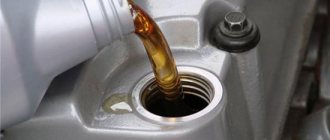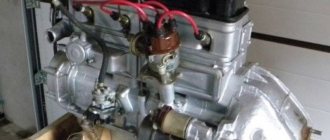| № | Name | Rating | Nomination |
| The best transmission oils for Lada Vesta with manual transmission and robot | |||
| 1 | Castrol Syntrans Transaxle | 4.83 | Most effective |
| 2 | Rosneft Kinetic MT | 4.80 | The most accessible for mechanics |
| 3 | ZIC GFT | 4.78 | Most popular |
| The best transmission oils for LADA Vesta with CVT | |||
| 1 | NISSAN NS-3 | 4.75 | Best according to the automaker |
| 2 | TOTACHI ATF NS-3 | 4.73 | The most affordable for CVTs |
| 3 | Ravenol CVTF NS3/J4 | 4.70 | Best for cold winters |
Transmission oil removes heat, reduces the load on gearbox parts, which significantly increases its service life. Car owners periodically change the oil partially, since to completely change it you need to disassemble the box. But, if possible, completely drain the old and fill in the new.
Why does liquid waste its potential?
The lubricant contains the main component of oil refining and a set of specialized additives. During operation of the machine, the liquid gradually loses the necessary characteristics and reduces efficiency indicators, which leads to the following negative changes:
- the appearance of unpleasant noise or knocking;
- structural parts lose their properties;
- the mechanism begins to spontaneously switch off gears or does not work quite clearly;
- The main gear and additional elements may fail.
The operating time of transmission oil directly depends on the driving habits of the car. The service life can be halved if the owner allows himself to be aggressive on the roads, starting with slipping. This puts significant pressure on gearbox components and leads to their rapid wear.
Most Lada Vesta buyers think about replacing the factory fluid with a better one after 4-5 thousand km. mileage because they don’t trust it. Changing the oil in the automatic transmission would be necessary if the “automatic” was built into the VAZ new product, but it is characterized only by “robot” and “mechanics”. The installation of an automated box is expected for future expensive modifications from VAZ.
Types of gearboxes on Vesta
The transmission component on this Lada model is quite diverse. Initially, Vesta was produced with “mechanics” from Renault and VAZ’s “robot” AMT (as an alternative to an automatic transmission). But a year later, the French gearshift was abandoned in favor of a modified manual transmission.
You can determine which gearbox is on your car by the VIN code designations:
- GFL11 – manual transmission VAZ-21807;
- GFL12 – AMT robotic gearbox;
- GFL13 – Renault JH3 510 manual transmission.
The most notable brands of gear oil for Lada Vesta
The choice of transmissions for manual and robotic gearboxes, as well as working fluid for the Lada Vesta CVT, is quite sufficient. Among the leading manufacturers are NISSAN, Rosneft, Castrol, TOTACHI.
Castrol
- an expensive transmission made in Europe, which is very popular among buyers for its impeccable characteristics.
NISSAN
- the brand chosen by the car plant. The working fluid of this brand is poured into Vesta cars with a continuously variable transmission. It’s not a cheap pleasure, but it reliably protects the box and prolongs its service life.
Rosneft
— it is also poured at AvtoVAZ, only in manual boxes. The quality of the transmission oil meets the requirements that the gearbox manufacturer places on it.
TOTACHI
— a transmission from a Japanese brand that retains its properties for a long time. It is often chosen by drivers who do not like to constantly change the oil.
Top 2. Rosneft Kinetic MT
Rating (2021): 4.80
The most accessible oil for mechanics The oil that AVTOVAZ chooses for its cars has excellent properties and the lowest price per 1 liter. rn
- Characteristics
Average price: 462 rub./l
- Country Russia
- Type: semi-synthetic
- API Standard: GL-4
The car plant chose semi-synthetic gear oil from the domestic brand Rosneft for its cars. Cars with manual transmission leave the assembly line with it, and it is recommended to put it in the box in the future. The oil is all-season and meets the requirements of foreign and domestic manufacturers of mechanical transmissions. It protects synchronizers that operate at high temperatures, ensures smooth operation of the box and protects its parts that are subject to contact loads. Car owners like how the oil behaves in cold weather - it does not thicken, and the gears fit in easily. But in the heat, some drivers feel that it becomes quite liquid, which makes switching difficult.
Advantages and disadvantages
- Recommended by the manufacturer
- Low price
- Doesn't thicken in cold weather
- Good anti-wear properties
- Very liquid in hot weather
See also:
- 20 best products from AliExpress for Lada Vesta
Changing the oil in the robot
Changing the oil in the robot
Changing the oil in the robot must be done regularly, and the selection of oil must be approached carefully. A lot depends on the quality of the oil in the robotic box. Even more depends on the quality of the replacement work - reliable and long-term operation of the box, your comfort and peace of mind. Trust this procedure only to professionals. A mistake can cost a costly and time-consuming repair.
Complete hardware oil change
from 600 rubles
Today there are several types of automobile transmissions. Although mechanical and automatic gearboxes are more popular, robotic gearboxes are increasingly gaining their place in the sun. They are also called “robots”. As with any other transmission, timely oil changes in the robot are an integral part of the reliability of its operation.
The robotic gearbox is essentially the same as the manual one, only it has a built-in module for automatically adjusting the clutch and gear shifting. Users of robots note the soft operation of the unit, smooth gear shifting, smooth acceleration and lower fuel consumption than with mechanics.
How often does the robot need to change oil?
The best option for determining when to change the oil is the manufacturer's recommendation. However, these will be approximate dates, since any oil, even if the car is idle for a long time, will lose its lubricating properties. Sudden temperature changes will contribute to the appearance of tar deposits on the internal surfaces of the transmission.
All these nuances should be taken into account when deciding to change the oil. Basically, for all cars, the factors that indicate that it is time to change the oil in the robot will be the following:
- quality of the previous oil
. If you bought cheaper oil, then you shouldn’t delay the next lubricant change; - if the oil change was carried out by dubious technicians
. It is possible that the internal cavity of the transmission was not flushed during the last lubricant change; - driving style
. If the machine is operated for a long time at maximum loads and in off-road conditions.
By external signs you can also determine that the oil in the robot needs to be changed. To do this, you need to take an oil sample from the box, having first unscrewed the filler plug. If the appearance of the oil has become significantly darker than when it was fresh, this means that it has partially lost its lubricating properties.
A burning smell or other aroma uncharacteristic of fresh oil will also be a signal to change the lubricant soon. The cause of the burning smell will be frequent and prolonged overheating of the transmission, long-term operation at high speeds.
Recommendations for changing the oil in the robot
In principle, there is nothing complicated in the procedure for changing the lubricant in a robot. Many car enthusiasts call this “working for an hour.” It would seem that without allowing the oil to cool, place the car on a flat surface, unscrew the drain and filler plugs and wait until the used oil is completely drained into a previously prepared container. Then close the drain plug and add fresh oil.
Our experts categorically do not recommend changing the oil in the robot with your own hands. The fact is that at the station, technicians using special equipment will wash the inside of the box. This will prevent old oil from mixing with fresh oil. This will have a positive effect on the service life of the filled oil. Cleanliness of the oil is the key to long-term operation of the unit without mechanical damage.
The auto technical center will also recommend choosing the right oil that matches the make of the car. The market is constantly changing, perhaps a better product has appeared at a good price. The auto repair center will provide a guarantee and additional recommendations for operating the robot. If desired, it will be possible to perform additional diagnostics of the general condition of the transmission.
It is always better to prevent a disease than to treat it. Likewise with changing the oil, regular transmission maintenance can be considered an inoculation against a serious illness in the form of an expensive breakdown.
What does oil viscosity affect?
The viscosity of transmission oil has a great influence on the vehicle's gearbox. With high viscosity, delays in gear shifting may occur, the sliding time of gearbox components increases, which increases wear, but reduces the noise of the gearbox. Oil, on the contrary, with low viscosity, is not able to create a strong film between surfaces. So, if it is destroyed, the elements begin to work “dry”, which contributes to wear.
You can easily feel the viscosity of the oil in winter at very low temperatures when starting the car.
Changing the oil in a robot is a bit of a difficult task, because... the factory did not provide for this operation. To replace, you will need a large syringe for pumping oil. Home page
Changing engine oil Lada Vesta
The most in demand is changing the lubricant in the power plant. The engine experiences constant loads and operates at high temperatures. This feature leads to wear of the lubricant and depletion of additives. The fact ensures the need to replace the working formula. To perform the operation correctly, you will need knowledge of several nuances.
What kind of oil to pour into the engine
From the factory, the car is delivered to the market with the Rosneft Magnum Maxtek 5W30 formula, which corresponds to the characteristics of the internal combustion engine. If such a liquid is not available, you can safely use oils:
- Mobil 5W40;
- Castrol Magnatec 5W30;
- Lukoil Lux 5B40.
You can also choose an analogue according to the parameters at your discretion.
- As a base, only hydrocracking semi-synthetics or completely artificial mixtures based on PAO or esters should be used. Fluids ensure high-quality engine operation and maintain optimal efficiency under increased loads.
- Viscosity is not important for the assembled structures - power plants do not differ in specific requirements. Consequently, lubricants can be selected from the general SAE table, where groups 5W30/5W are acceptable for the Russian climate
- It is also recommended to adhere to the API SM, ACEA A3/B3, AvtoVAZ tolerance groups. At the same time, it is permissible to fill in liquids exceeding the specified standards.
How much oil to pour into the Lada Vesta engine
Depending on the configuration, the service fluid volumes are as follows:
- 1.6/1.8 l automatic – 3.2 liters;
- 1.6/1.8 liters manual/robot – 4.4/4.1 liters.
How often to change
The manufacturer recommends changing the lubricant in the engine every 15,000 kilometers. The service interval is optimal for the design of the power plant and moderate operating conditions. In severe conditions (city traffic, off-road), the lubricant operating time should be reduced to 10,000 - 12,000 kilometers. At the same time, you should know that on the Lada Vesta the first oil change is performed already at around 2500 km.
Some car enthusiasts update even more often (about 7,000 km), which only extends the life of the power plant.
Changing the oil in the Lada Vesta engine
The sequence of actions is as follows.
- Warm up the engine and drive the car into the inspection pit.
- Prepare a container for draining the waste and the required tools.
- Open the filler neck, having first removed the plastic casing.
- From below, using head No. 10, unscrew the 13 bolts of the crankcase protective cover.
- Next, you need to place the prepared container under the drain hole and unscrew the lid.
- After draining the waste, you will need to remove the oil filter. The element can be removed by punching a hole in it and inserting a screwdriver into it, using it as a lever. You can also use a special chain whip.
- Install a new filter.
- Close the bottom plug.
- Pour the required amount of lubricant into the motor through the filler neck.
- Install the protective covers in reverse order.
What oil does VAZ recommend?
The general recommendations of the AvtoVAZ plant for choosing engine oil for all its models are very similar. The first thing you need to decide is the temperature conditions for which the oil is selected.
For different regions, as well as for winter or summer operating conditions, it is necessary to select different temperature conditions and oil viscosity in accordance with the table:
Next, you need to select the brand and grade of oil recommended by the manufacturer for each car model.
Replacing fluid in manual transmission Lada Vesta
On a warm Lada Vesta we drive onto a pit or lift. The used liquid must be drained immediately, because when it cools down it becomes more viscous and leaks worse.
- First, we de-energize the Lada by removing the terminal from the battery;
- We remove attachments that obstruct the path to the filler hole: air filter, pipes;
- We unscrew either the control plug with a size 17 wrench, or the reverse switch, having first removed the wires from it (wrench 22). The location of the switch is more convenient for filling oil.
- We go down, dismantle the technological hole for draining the oil from the gearbox or completely remove the engine protection (key 14 or 17);
- We substitute a container for “working off” with a volume of 2.5 liters (2.2 to be precise);
- Using a 17 wrench, unscrew the drain plug in the crankcase;
- We wait for some time, let the liquid drain completely;
- Screw the plug into place;
- We insert a hose with a clean funnel into the switch or control hole, change the oil to the lower edge of the control plug or, more simply, until lubricant flows out of it;
- After all the manipulations, close all the holes and check them for leaks. Then we install the protection in place. We remount the VF Frets, the removed pipes and terminals.
How to change oil fluid
Changing the fluid takes about 20 minutes. Warmed grease is easier to drain, so it is recommended to drive 5-10 km before the operation. The driver will need: keys, screwdrivers, a container for old substances, a hose and a funnel. The car should be placed on an overpass.
- Disconnect the negative connection to the battery.
- Remove the air filter.
- Disconnect the reverse wires.
- Having unscrewed the plugs with a key 17, drain the oil into the container.
- Insert the hose into the reverse hole. The new substance must be poured through a funnel.
- Having completely filled the tank, connect all terminals and wires, close all plugs.
If the quality of the drained oil is very poor (there are metal particles), the gearbox must be washed with a liter of flushing fluid, warming up the gearbox in second gear for 5-6 minutes.
The official Vesta maintenance regulations do not include the item of updating the transmission oil. Many motorists can agree with the factory that there is no need for this - the filled oil should last throughout its entire service life. But there are also many who believe that an oil change in the Lada Vesta gearbox is necessary even after the first maintenance. Whether it is necessary to do this - read our article.
Recommendations for choosing oil for Lada Vesta
Manufacturer's recommendations.
All cars that leave the AvtoVAZ checkpoint are filled with technical fluids. The manufacturer uses synthetic oils SAE5W-30 or SAE5W-40 from well-known Russian oil companies Lukoil and Rosneft on the conveyor. These products are also recommended for dealerships that service vehicles under warranty. Lubricants are all-season, they can successfully protect engine components at both high (30..35°C) and low (-30..-35°C) temperatures. The interval between replacements is 15 thousand km, but experts advise the first replacement after running-in to be carried out after 1.5-2.0 thousand km.
Mileage factor.
Lada Vesta cars are still young (production began in 2015), so many owners visit service centers for warranty maintenance. But after the warranty expires, many motorists will switch to changing the oil themselves. Then you will have to take into account the mileage factor.
When the car's mileage is within 150-200 thousand.
km it is best to use multi-grade oil designated 5W30, 5W40 or 10W30. Synthetic products meet these requirements.
When the engine has worked out more than a quarter of its service life
, it is allowed to use mineral or semi-synthetic oil 15W40 or 10W40 in the summer. If the winter in the region is harsh, then there is no alternative to synthetics.
Features of operation.
The engine oil change interval depends on the operating conditions of the vehicle. Car enthusiasts with a relaxed driving style who live in small towns can change the oil after 15 thousand km. But residents of megacities spend a lot of time in city traffic jams. If a motorist likes dynamic driving, then the service life of the lubricant is limited to 10 thousand km. These indicators apply only to synthetics.
We have selected 9 best oils for Lada Vesta for review. All lubricants can be purchased at auto stores across the country. When compiling the rating, the opinion of the expert community and reviews of car enthusiasts were taken into account.
Bottom line
Changing factory oil to an imported analogue makes sense only for those who prefer to use the car in intensive mode, where high engine speeds predominate; in this case, imported analogues perform better.
When driving moderately, it is better to replace with the same oil that was filled from the factory; it will definitely not harm the engines, and it is cheaper, plus the risk of purchasing low-quality fakes disappears.
The main thing is to regularly monitor the oil level and change it at the required intervals, which are indicated in the car owner's manual.
Oil in manual transmission Lada Vesta
Taking into account the fact that the manual transmission version of the Lada Vesta remains the most common and in demand, next we will consider the issue of changing the oil on the manual transmission, as well as what is poured into the Vesta box from the factory.
First of all, although the manufacturer claims that this gearbox is maintenance-free and is designed for the entire service life of the car, many car enthusiasts claim that the oil filled at the factory is far from the best quality. When replacing, there is often a significant loss and deterioration in mining properties after 40-60 thousand km. mileage It turns out that with long-term use of such oil without replacement, a reduction in service life and other problems are inevitable.
At the factory, the Vesta box is filled with TM-4-12 SAE 76W-85 GL-4 oil. This product is semi-synthetic, designed for year-round use (all-season gear oil). This oil also contains a package of imported additives and is designed to operate at temperatures from -40 to +45 degrees Celsius. The total oil volume in the Lada Vesta gearbox is 2.2 liters.
Read also: Oil in Kamaz 740 engine camber reasons
As for changing the oil, you can either try to purchase exactly the same fluid or choose other analogues
It is important to take into account a number of features. Many experts recommend using semi-synthetic ZIC G-FF 75W-85 in the Lada Vesta transmission
You can also pay attention to fully synthetic oils
Otherwise, “inappropriate” oil can lead to problems with the gearbox, failure of individual elements, increased wear and damage to synchronizers, etc. For reference, if the manufacturer specifies that only GL-4 oils should be poured into the gearbox, the use of higher class oils such as GL-5 can cause rapid failure of the gearbox synchronizers.
How to change the oil in a Lada Vesta gearbox
Having figured out what kind of oil the factory pours into the Vesta manual transmission, as well as how to select analogues for replacement, let’s move on to replacing the transmission fluid itself. In order to change the oil in the Vesta gearbox or Lada Vesta AMT (robotic automated mechanics), you need to prepare:
- necessary keys;
- slotted screwdriver;
- container for draining waste (up to 3 liters);
- rags (clean rags);
- hose with a diameter of 20 mm and a funnel;
- 4-6 liters of fresh oil (with reserve for topping up or flushing);
The oil change itself in the Lada Vesta gearbox comes down to the following:
- lift the car on a lift or drive it into a viewing hole;
- the car must be positioned level, without slopes;
- remove the engine protection;
- Next, you will need to unscrew the oil level control plug in the gearbox;
- then you should find the drain plug and place a prepared container under it to drain the waste;
- then you need to unscrew the drain plug with a 8mm square wrench and wait until the transmission fluid completely drains into the container;
- after complete drainage, the drain plug should be screwed in; if necessary, the seal can be replaced;
- Now a hose with a funnel is inserted into the control hole, after which fresh oil is carefully poured in small portions;
- when the level rises to the edge of the hole, the replacement can be considered complete;
- Now the inspection hole plug can be tightened and the engine protection can be put in place.
Manufacturer's recommendations
AvtoVAZ does not regulate the time and period for changing transmission oil in a robotic gearbox. The oil in the box is designed for the entire service life of this unit. Should you trust the factory in this matter? NO!
Immediately after purchasing a car, you need to take a more careful approach to the issue of choosing oil for a robotic gearbox. Since at this time all components undergo a break-in period, the conditions of which determine the further operation of the car as a whole. But even after running in, you shouldn’t neglect the quality of the oil; it’s a pity that now is a time when absolutely everything is counterfeited and it’s easy to stumble across a fake.
What do they pour out of the factory?
Transmission oil TM-4-12 SAE 76W-85 GL-4 is poured into Vesta’s robotic gearbox from the factory. Another new product, XRAY, is pouring exactly the same thing. We can conclude that the oil poured in from the factory is the recommended one, but this will not be an entirely correct statement.
Factory fluid quality
As mentioned above, the manufacturer fills the AMT with oil for its entire service life. But we decided to drain it and see what awaits us in the box when the odometer shows 3.5 thousand km. Look at the photo: Factory transmission oil is a kind of liquid with strange brown and gray shades, with pieces of chips. I'm not sure that such oil would extend the life of the robot.
This is the kind of oil that is poured into the robot from the factory.
Many drivers notice a whine in the operation of the gearbox, noting the low quality of the factory oil in the Vesta gearbox. Therefore, it is recommended that after purchasing a new or used car, replace it with higher quality oil to reduce noise and extend the life of the gearbox. What about other manufacturers? To do this, let's turn to the vehicle's operating manual: - LUKOIL TM-4 - 75W-80, 75W-85, 75W-90, 80W-85, 80W-90; TG-4 - NOVOIL TRANS KP - 80W-85; TG-4 - ROSNEFT KINETIC - 80W-85; TG-4 - TNK TRANS KP - 80W-85; TG-4 - TNK TRANS KP SUPER - 75W-90; TG-4 - TRANS KP-2 - 80W-85; TG-4 - SHELL TRANSAXLE OIL - 75W-90; TG-4/5 Basically, the entire Lada line has similar recommended gear oils. This is explained by the fact that some car models have the same or modernized old gearboxes. So, for example, Vesta’s robot was based on a VAZ 2180 mechanic, it was simply equipped with an automatic switching system.
It is allowed to pour oil TG-4/5, TG-4, but not TG-5. TG-5 is considered gear oil, pouring it into the gearbox will kill the synchronizers.
Technical characteristics of popular Liqui Moly oils
Since the company’s product range is very extensive and continues to expand, it makes sense to provide a description of the features and technical characteristics of the most popular oils for different types of transmissions.
Hochleistungs-Getriebeoil 75W80
Hochleistungs-Getriebeoil 75W80 oil is intended for use in robotic preselective gearboxes. Provides quick engagement and disengagement of friction clutches, optimal functioning of hydraulic servos, high-quality lubrication of synchronizers, gears and other transmission parts. Features of Hochleistungs-Getriebeoil 75W80 liquid:
- almost ideal viscosity-temperature properties;
- excellent shear stability;
- high wear resistance;
- excellent antioxidant properties, resistance to aging.
Specifications:
- viscosity index at a temperature of 40° C – 33.00 mm2/s;
- viscosity index at 100° C – 6.85 mm2/s;
- viscosity index at a temperature of -40° C – no more than 20,000 mPas;
- ignition temperature – 200° C;
- critical crystallization temperature – minus 48° C.
Top Tec MTF 75W80
Top Tec MTF 75W80 oil is used in mechanical gearboxes, power take-off units and transfer cases. Recommended for use in manual transmissions from most well-known car manufacturers. It is characterized by a high degree of protection of transmission components from wear.
Features of Top Tec MTF 75W80 fluid:
- ensuring fuel efficiency;
- excellent anti-corrosion properties;
- resistance to high loads;
- decent viscosity-temperature parameters;
- ensuring optimal operation of synchronizers.
Specifications:
- viscosity index at a temperature of 40° C – 53.60 mm2/s;
- viscosity index at 100° C – 9.30 mm2/s;
- viscosity index at a temperature of -40° C – no more than 150,000 mPas;
- ignition temperature – 202° C;
- critical crystallization temperature – minus 45° C.
Getriebeoil 85W90
Getriebeoil 85W90 is a GL4 class mineral transmission fluid intended for use in manual transmissions of trucks and passenger vehicles. It is characterized by the use of base mineral components of the highest quality and a complex of additives and modifiers that ensure clear and fast gear shifting.
Features of Getriebeoil 85W90 oil:
- possibility of use in gearboxes with all types of bevel and cylindrical gears;
- full compatibility with all modern seals;
- all-season use.
Specifications:
- viscosity index at a temperature of 40° C – 197.00 mm2/s;
- viscosity index at 100° C – 17.60 mm2/s;
- viscosity index at a temperature of -12° C – no more than 150,000 mPas;
- ignition temperature – 220° C;
- critical crystallization temperature – minus 15° C.
Hypoid-Getriebeoil TDL 75W90
Transmission oil Hypoid-Getriebeoil TDL 75W90 is a semi-synthetic fluid designed for filling into manual transmissions of passenger and heavy vehicles, drive axle gearboxes and transfer cases. It features high-quality protection of transmission parts from wear and ensures clear and fast gear shifting.
Features of Hypoid-Getriebeoil TDL 75W90 fluid:
- wide range of temperature conditions;
- ability to provide high temperature and viscosity stability;
- Possibility of use in highly loaded transmissions.
Technical characteristics of gear oil Liqui Moly 75w90 Hypoid-Getriebeoil TDL:
- viscosity index at a temperature of 40° C – 81.20 mm2/s;
- viscosity index at 100° C – 14.20 mm2/s;
- ignition temperature – 180° C;
- critical crystallization temperature – minus 43° C.
Hochleistungs-Getriebeoil 80W90
Hochleistungs-Getriebeoil 80W90 is a synthetic fluid of class GL-4/5, intended for filling into manual transmissions of passenger cars, including models in which the transmission is coupled to the final drive. The oil ensures clear and fast gear shifting and effective protection of transmission parts from wear.
Liqui Moly Hochleistungs-Getriebeoil 80w90 gear oil has the following special properties:
- excellent temperature-viscosity properties;
- effective protective action against corrosion and wear;
- possibility of use in highly loaded transmissions;
- easy gear shifting.
Specifications:
- viscosity index at a temperature of 40° C – 77.00 mm2/s;
- viscosity index at 100° C – 14.00 mm2/s;
- viscosity index at a temperature of -40° C – no more than 150,000 mPas;
- ignition temperature – 215° C;
- critical crystallization temperature – minus 42° C.
Changing the Lada Vesta oil step by step in the engine and gearbox
The Lada-Vesta family made its debut on the Russian market relatively recently. Most cars are new, so issues of independent maintenance are relevant for car owners. A popular topic is changing the Lada Vesta oil, both engine and transmission.
Engine oil Lada Vesta
Let's consider the requirements for engine oil for Vesta and Vesta SV-Cross cars. The volume of lubricant poured is 4.4 liters. The recommended fluid type is synthetic oil with a viscosity grade of 5W-40. This degree of viscosity ensures uninterrupted operation of the internal combustion engine at air temperatures from -30ºС to +35ºС. Recommended.
The first oil change on a Lada Vesta is carried out at “zero” maintenance, when the mileage reaches 3 thousand km. The automaker recommends changing the oil during scheduled maintenance, that is, every 15 thousand km. AvtoVAZ recommends that all work be carried out by authorized dealerships.
Transmission oil for Lada Vesta
The choice of gear oil depends on the type of gearbox installed on a particular vehicle. For Vesta, the manufacturer provides a 5-speed manual (2 versions, one of which is made by Renault) or a “robot” with a similar number of gears.
According to the technical documentation, an oil change in the AMT Lada Vesta is not required during the service life of the car.
Changing the oil in the manual transmission of the Lada Vesta is recommended once every 4 years or every 75 thousand km. If the car has a French-assembled gearbox, then the interval can be increased. The working volume of transmission lubricant is 2.2 liters. It is recommended to use compositions of the Zic and Rosneft brands.
Changing the oil in the Lada Vesta engine
To change the engine oil, the Lada owner will need:
- universal wrench with replaceable heads;
- hexagons;
- chain puller;
- new oil filter;
- container for “working off”;
Changing the oil and filter begins with dismantling the plastic covers in the engine compartment. You also need to unscrew the plastic engine protection located at the bottom of the front of the car.
After this, the drain plug is unscrewed.
First, place a container under the plug into which the waste liquid will drain. The “working off” can drain for up to half an hour, so you will have to wait until the old lubricant is completely removed from the engine.
After this, we tighten the drain plug of the pan and install the plastic protective casing in its original place. Next, use a chain puller to remove the oil filter. The new filter is filled with fresh lubricant in half the container.
A particular disadvantage when changing the oil is the location of the engine oil filter, and some car enthusiasts recommend unscrewing the filter from above the engine compartment.
Once the filter is installed, pour lubricant into the internal combustion engine through the neck under the hood. After filling, start the engine and let it idle for 4-6 minutes. For cars with AMT, 3.2 liters of oil are poured into the engine, for cars with manual transmission - 4.4 liters.
Flushing the gearbox
Not all car enthusiasts share the opinion that it is necessary to flush the transmission when changing the fluid. The manufacturer does not directly indicate the need in the operating instructions, but implies this procedure.
Service station technicians advise flushing the transmission constantly, especially if maintenance deadlines are not met or if there is long-term operation. The transmission oil changes color to dark, metal particles and waste products appear in the composition.
The flushing process is similar to replacing fluid in a manual transmission:
- We place the machine on a hydraulic lift and drain the waste.
- Through the control hole, fill in a volume of 1.5 liters of flushing, no more.
- We start the engine, engage first and second gear for 10 - 15 minutes.
- We drain the waste and fill in new oil.











